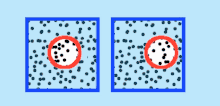Professor Stuart M. Anstis P.h.D. | |
|---|---|
| Alma mater | Cambridge |
Stuart M. Anstis is a professor emeritus of psychology at the University of California, San Diego, in the United States.
Anstis was born in the United Kingdom. He went to Winchester, and then to Corpus Christi, Cambridge, where he did his PhD under Richard Gregory. He had teaching posts at the University of Bristol in the UK, at York University in Toronto and – from 1991 – at the University of California in San Diego, California.[1] He is a fellow of the Society of Experimental Psychologists.[2] In 2013, Anstis won the Kurt Koffka Medal for "advancing the field of perception ... to an extraordinary extent".[3]
Books
- George Mather, Frans Verstraten, Stuart Anstis (1998). The Motion Aftereffect: A Modern Perspective. Cambridge, Massachusetts; London: MIT Press.
Research
Zigzag motion: Size determines perceived direction[4].

A texture of sparse random dots jumps repetitively through three units to the right and one unit down, as if descending a long staircase of shallow steps. When viewed from a distance, all jumps are visible and vertical drift is seen towards approximately 4 o'clock. However, when viewed from close up, one loses track of which dots are which (Dmax is exceeded) and the horizontal motion is not seen. Therefore, one perceives a downward drift towards 6 o'clock.
Bicycle Spokes[5] (with Brian Rogers[6])
-1-229_copy.gif)
The sectored gray disk steps around clockwise. The thin gray spokes never change their brightness or position, yet they appear to drift around counterclockwise. When stopped, they gave a brisk clockwise motion aftereffect. A spoke appears to move only when a sector of the same luminance effectively jumps across it. The effect is caused by small displacement across the thickness of the spokes, which stimulate hard-wired motion detectors. These tiny displacement are counterclockwise, but their locus around the disk steps clockwise.
References
- ↑ "Stuart Anstis". University of California, San Diego. Retrieved December 15, 2019.
- ↑ "Fellows". Society of Experimental Psychology. Retrieved December 15, 2019.
- ↑ "Kurt-Koffka-Medaille".
- ↑ jov.arvojournals.org https://jov.arvojournals.org/article.aspx?articleid=2193406. Retrieved November 17, 2023.
{{cite web}}: Missing or empty|title=(help) - ↑ Anstis, Stuart; Rogers, Brian (September 2011). "Illusory Rotation of a Spoked Wheel". i-Perception. 2 (7): 720–723. doi:10.1068/i0483. ISSN 2041-6695. PMC 3485806. PMID 23145255.
- ↑ "Brian Rogers". www.psy.ox.ac.uk. Retrieved November 17, 2023.